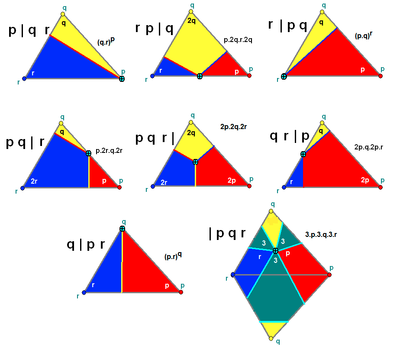Wythoff symbol


In
A Wythoff symbol consists of three numbers and a vertical bar. It represents one uniform polyhedron or tiling, although the same tiling/polyhedron can have different Wythoff symbols from different symmetry generators. For example, the regular
With a slight extension, Wythoff's symbol can be applied to all uniform polyhedra. However, the construction methods do not lead to all uniform tilings in Euclidean or hyperbolic space.
Description
The Wythoff construction begins by choosing a generator point on a fundamental triangle. This point must be chosen at equal distance from all edges that it does not lie on, and a perpendicular line is then dropped from it to each such edge.
The three numbers in Wythoff's symbol, p, q, and r, represent the corners of the Schwarz triangle used in the construction, which are π/p, π/q, and π/r
- p | q r indicates that the generator lies on the corner p,
- p q | r indicates that the generator lies on the edge between p and q,
- p q r | indicates that the generator lies in the interior of the triangle.
In this notation the mirrors are labeled by the reflection-order of the opposite vertex. The p, q, r values are listed before the bar if the corresponding mirror is active.
A special use is the symbol | p q r which is designated for the case where all mirrors are active, but odd-numbered reflected images are ignored. The resulting figure has rotational symmetry only.
The generator point can either be on or off each mirror, activated or not. This distinction creates 8 (23) possible forms, but the one where the generator point is on all the mirrors is impossible. The symbol that would normally refer to that is reused for the snub tilings.
The Wythoff symbol is functionally similar to the more general
Example spherical, euclidean and hyperbolic tilings on right triangles
The fundamental triangles are drawn in alternating colors as mirror images. The sequence of triangles (p 3 2) change from spherical (p = 3, 4, 5), to Euclidean (p = 6), to hyperbolic (p ≥ 7). Hyperbolic tilings are shown as a Poincaré disk projection.
| Wythoff symbol | q | p 2 | 2 q | p | 2 | p q | 2 p | q | p | q 2 | p q | 2 | p q 2 | | | p q 2 |
|---|---|---|---|---|---|---|---|---|
Coxeter diagram
|
||||||||
| Vertex figure | pq | q.2p.2p | p.q.p.q | p.2q.2q | qp | p.4.q.4 | 4.2p.2q | 3.3.p.3.q |
| Fund. triangles | 7 forms and snub | |||||||
(3 3 2)
|
3 | 3 2 33 |
2 3 | 3 3.6.6 |
2 | 3 3 3.3.3.3 |
2 3 | 3 3.6.6 |
3 | 3 2 33 |
3 3 | 2 3.4.3.4 |
3 3 2 | 4.6.6 |
| 3 3 2 3.3.3.3.3 |
(4 3 2)
|
3 | 4 2 43 |
2 3 | 4 3.8.8 |
2 | 4 3 3.4.3.4 |
2 4 | 3 4.6.6 |
4 | 3 2 34 |
4 3 | 2 3.4.4.4 |
4 3 2 | 4.6.8 |
| 4 3 2 3.3.3.3.4 |
(5 3 2)
|
3 | 5 2 53 |
2 3 | 5 3.10.10 |
2 | 5 3 3.5.3.5 |
2 5 | 3 5.6.6 |
5 | 3 2 35 |
5 3 | 2 3.4.5.4 |
5 3 2 | 4.6.10 |
| 5 3 2 3.3.3.3.5 |
(6 3 2)
|
3 | 6 2 63 |
2 3 | 6 3.12.12 |
2 | 6 3 3.6.3.6 |
2 6 | 3 6.6.6 |
6 | 3 2 36 |
6 3 | 2 3.4.6.4 |
6 3 2 | 4.6.12 |
| 6 3 2 3.3.3.3.6
|
(7 3 2)
|
3 | 7 2 73 |
2 3 | 7 3.14.14 |
2 | 7 3 3.7.3.7 |
2 7 | 3 7.6.6 |
7 | 3 2 37 |
7 3 | 2 3.4.7.4 |
7 3 2 | 4.6.14 |
| 7 3 2 3.3.3.3.7
|
(8 3 2)
|
3 | 8 2 83 |
2 3 | 8 3.16.16 |
2 | 8 3 3.8.3.8 |
2 8 | 3 8.6.6 |
8 | 3 2 38 |
8 3 | 2 3.4.8.4 |
8 3 2 | 4.6.16 |
| 8 3 2 3.3.3.3.8 |
(∞ 3 2)
|
3 | ∞ 2 ∞3 |
2 3 | ∞ 3.∞.∞ |
2 | ∞ 3 3.∞.3.∞ |
2 ∞ | 3 ∞.6.6 |
∞ | 3 2 3∞ |
∞ 3 | 2 3.4.∞.4 |
∞ 3 2 | 4.6.∞ |
| ∞ 3 2 3.3.3.3.∞ |
See also
- Regular polytope
- Regular polyhedron
- List of uniform tilings
- Uniform tilings in hyperbolic plane
- List of uniform polyhedra
- List of uniform polyhedra by Schwarz triangle
- Lists of uniform tilings on the sphere, plane, and hyperbolic plane
References
- ISBN 0-486-61480-8(Chapter V: The Kaleidoscope, Section: 5.7 Wythoff's construction)
- ISBN 0-486-40919-8(Chapter 3: Wythoff's Construction for Uniform Polytopes)
- Coxeter, Longuet-Higgins, Miller, Uniform polyhedra, Phil. Trans. 1954, 246 A, 401–50.
- ISBN 0-521-09859-9. pp. 9–10.
External links
- Weisstein, Eric W. "Wythoff symbol". MathWorld.
- The Wythoff symbol
- Greg Egan's applet to display uniform polyhedra using Wythoff's construction method
- A Shadertoy renderization of Wythoff's construction method
- KaleidoTile 3 Free educational software for Windows by Jeffrey Weeks that generated many of the images on the page.
- Hatch, Don. "Hyperbolic Planar Tessellations".
